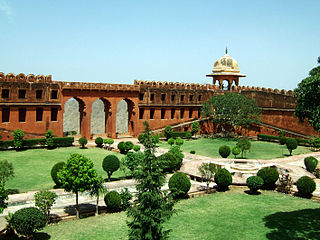Jaigarh Fort
15 kms from Jaipur, 400 ft above the Amber Fort
Phone:0141 267 1848
Jaigarh Fort is situated on the promontory called the Cheel ka Teela (Hill of Eagles) of the Aravalli range; it overlooks the Amber Fort and the Maota Lake, near Amber in Jaipur. The fort was built by Jai Singh II in 1726 to protect the Amber Fort and its palace complex and was named after him.
The fort, rugged and similar in structural design to the Amber Fort, is also known as Victory Fort. It has a length of 3 kilometres (1.9 mi) along the north–south direction and a width of 1 kilometre (0.62 mi). The fort features a cannon named “Jaivana”, which was manufactured in the fort precincts and was then the world’s largest cannon on wheels. The palace complex includes (Laxmi Vilas, Lalit Mandir, Vilas Mandir and Aram Mandir), an armoury and a museum. Jaigarh Fort and Amber Fort are connected by subterranean passages and considered as one complex.
It provides an excellent of view of Aravalli hills and the Amber Fort down below.
Description
The fort is highly fortified with thick walls of red sandstone and is spread over a layout plan with a length of 3 kilometres (1.9 mi) and a width of 1 kilometre (0.62 mi); it has an impressive square garden (50 metres (160 ft) square) within it. Ramparts in each corner are sloping and provide access to the upper level structures. The palaces have court rooms and halls with screened windows. A central watch tower on a raised ground provides excellent vistas of the surrounding landscape. The Aram Mandir and the garden within its courtyard, on the northern side of the fort complex, has a triple arched entrance “The Awani Darwaza” which was refurbished in recent times to get fine views of the Sagar Lake (an artificial lake); water from this lake used to be transported to the fort in pouches loaded on elephant backs and also by humans carrying water pots. The triple arch gateway with fortification walls above it is painted red and yellow. It is oriented in an east–west direction and faces west. The architectural features are of Indo-Persian style with cyclopean walls built with dressed stone and plastered with lime mortar. There are two temples within the fort precincts, one is the Ram Harihar temple of the 10th century and the other one is the Kal Bhairav temple of 12th century vintage.
Water supply
The water supply facilities in the fort was met by creating water harvesting structures in the vicinity in the Aravalli catchment and conveying water through a canal on the west side of the fort over a 4 kilometres (2.5 mi) distance (seen at site) to be stored in three underground tanks below the central courtyard. The largest tank had a capacity of 6 million gallons of water.
Armoury
The armoury chamber here has a wide display of swords, shields, guns, muskets and also a 50 kilograms (110 lb) cannonball. Pictures on display are old photographs of Jaipur’s Maharajas namely, Sawai Bhawani Singh and Major General Man Singh II who served in the Indian Army as senior officers.
Museum
The museum is located to the left of the Awami Gate; it has exhibits of photographs of the Royalty of Jaipur, stamps and many artefacts, which include a circular pack of cards. A spittoon of 15th century vintage and also hand drawn plan of the palaces are seen in the museum.
Jaivana cannon
Jaigarh Fort was a centre of artillery production for the Rajputs. It is now home to the Jaivana – at the time of its manufacture in 1720, it was the world’s largest cannon on wheels of the Early Modern Era. The foundry where it was manufactured is also located here. A plaque at the entrance to the enclosure where the Jaivan Cannon is displayed gives relevant information on the history of the Cannon, its size and use. This cannon was never used in any battle as the Rajput rulers of Amber had friendly relations with the Mughals. This testifies to well-preserved features of fort. The cannon was fired only once with a charge of 100 kilograms (220 lb) of gunpowder and when fired covered a distance of about 35 kilometres (22 mi).

The Jaivana was manufactured during the reign of Maharaja Sawai Jai Singh II (1699–1743) at a foundry in Jaigarh. The barrel is 20.19 foot (6.15 m) in length and weighs 50 tonnes. It has a diameter of 11 inches (280 mm). The barrel has decorations carved on it which depict trees, an elephant scroll and a pair of birds (ducks). It is mounted on wheels and has the mechanism of two back wheels mounted on roller pin bearings, to turn it 360° and fire in any direction. A tin shed was built to protect the cannon against weather. The cannon had a range of 22 miles and used 50 kilograms (110 lb) balls.
source : wikipedia
https://www.youtube.com/watch?v=ND4ui0xs0Yk
https://www.youtube.com/watch?v=Id2oMU2Ly3E
Reviews
Visiting hours : 09.00AM to 04.30PM, all days of the week
Entry fee : Rs.35/- for Indians and Rs. 85/- for foreign tourists




Rate this article